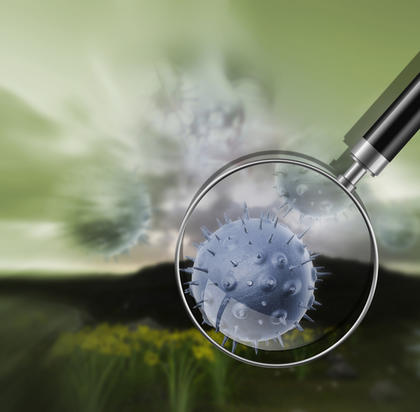 Up to now, research into pollen allergies has largely focused on allergens – those components of pollen that trigger hypersensitivity reactions. When it comes into contact with the nasal mucous membrane, however, pollen releases a host of other substances in addition to allergens. In a pilot study, a team of researchers from the Technical University of Munich (TUM) and the Helmholtz Zentrum München investigated for the first time the effects of these substances on allergy sufferers. It emerged that the non-allergenic components of pollen have a significant influence on the way the body reacts. The results of the study suggest that it may be time to rethink the current methods of treating allergies.
Up to now, research into pollen allergies has largely focused on allergens – those components of pollen that trigger hypersensitivity reactions. When it comes into contact with the nasal mucous membrane, however, pollen releases a host of other substances in addition to allergens. In a pilot study, a team of researchers from the Technical University of Munich (TUM) and the Helmholtz Zentrum München investigated for the first time the effects of these substances on allergy sufferers. It emerged that the non-allergenic components of pollen have a significant influence on the way the body reacts. The results of the study suggest that it may be time to rethink the current methods of treating allergies.
In April and May, birch pollen makes life miserable for many people. The body’s defense mechanism is primarily triggered by a protein called Bet v 1, which is the main allergen of birch pollen. For a team of researchers under Prof. Claudia Traidl-Hoffmann from TUM, however, this allergen is not the focus of their interest. Instead, their study involved filtering the metabolic products of birch pollen so that only non-allergenic low molecular substances remained in the extract – that is, substances with particularly small molecules.
One part of the experiment saw the researchers performing a skin prick test on hay fever sufferers with various combinations of allergens and low molecular substances. They also administered some of the mixtures through the nasal passages of the study participants.
The results were clear: In both the skin prick test and the nasal inhalation approach, the reactions were much stronger when the low molecular substances were administered along with the allergen. In cases where both were injected under the skin, extremely pronounced reddening and swelling occurred. When the mixture was administered through the nose, the study participants experienced a strong build-up of mucus and their immune systems produced a large number of antibodies. No effect was discernible, however, when the low molecular substances were administered by themselves to the allergy sufferers.
Reaction not limited to those allergic to birch pollen
The researchers noticed that the birch pollen extract did not just have an effect on the test subjects who react to Bet v 1. The effect was also evident in those who are allergic to grass pollen and who were nasally administered the corresponding allergen in combination with the birch pollen extract. The explanation behind this is that many of the low molecular substances also occur in other plant pollens. “The inflammatory effect of the low molecular components is non-specific, i.e. it is not connected to any one allergen” explains Claudia Traidl-Hoffmann. “We suspect that effects could even be noticed in people who do not suffer from allergies.”
The birch pollen extract contains as many as 1,000 different low molecular substances. The researchers were able to identify some of the components that heighten allergic reactions in earlier studies – components like adenosine and various fatty acids. Irrespective of the fact that scientists do not yet understand how all of these components work, it seems that the interaction between different substances also plays an important role in the occurrence and effects of allergies. “The human organism is a complex system. We can hardly expect to pinpoint the cause of allergies to one single substance,” comments Traidl-Hoffmann.
Negative effects on immunotherapy
The finding that non-allergenic substances in pollen have a major influence on the body’s response could have a lasting impact on the medical treatment of allergies. During specific immunotherapy (hypo-sensitization), doctors currently administer a pollen extract in liquid form containing all the components of pollen. This means that components like the low molecular substances investigated in this particular study also make their way into the human organism. “At present, only 60 to 70 percent of hypo-sensitization therapies work,” points out Traidl-Hoffmann. One reason for this might be the presence of non-allergenic but pro-inflammatory contents that could have a negative impact on treatment. A more helpful way to treat allergy sufferers could be vaccination with recombinant proteins, which are derived from biotechnology. This would allow selective administration of the allergen by itself so that the body can become accustomed to its effects. To date, recombinant protein therapy has only been developed for people with an allergy to wasp and bee venom.
Filed Under: Drug Discovery




